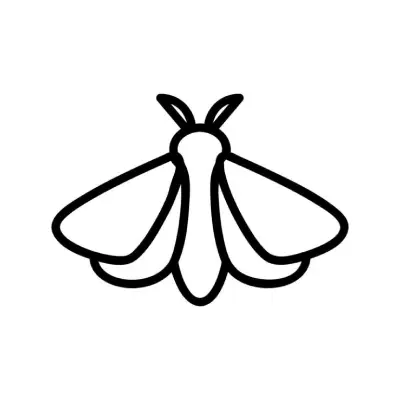Moths Control Protect Your Home from Infestations
Moths may seem small and harmless, but moths in the house can cause significant damage if left unchecked. They sneak into your cupboards, closets, and storage areas, feeding on fabrics, food, and other household items. The first step in moths control is understanding the types of moths that invade homes. Most Canadian homes encounter household moths, which can be either clothes moths or pantry moths. Clothes moths damage fabrics such as wool, silk, and fur, while pantry moths feed on grains, cereals, and stored food. Recognizing the signs of an infestation is crucial. Look for small holes in fabrics, silky webbing in corners of closets, or tiny moths fluttering near your cupboards. Effective moth prevention begins with proper identification. Household moths identification is a skill every homeowner should have, as it informs the best strategies for keeping these pests away from your home.
Beyond identification, understanding the moth life cycle is essential. Moths go through several stages: egg, larva, pupa, and adult. It is the larvae of moths that cause most damage to fabrics and food. Tiny moth larvae in house are often invisible to the naked eye initially but can quickly multiply if ignored. Early detection can save your home from long-term damage. Regularly inspecting wardrobes, pantry shelves, and storage areas helps spot small moths in house before they establish large colonies.
Identifying Moths in Your Home
Before starting moths control, it’s important to identify moths in house correctly. Not all moths are harmful; some may accidentally enter your home but do not cause damage. Typical household invaders include small brown or tan moths and sometimes coloured moths. Clothes moths are usually lighter in color, with shiny golden wings, whereas pantry moths often appear darker with distinctive patterns. If you find tiny moths in house, check nearby fabrics and food storage areas to see where the problem originates.
For accurate house moths identification, you can observe these key traits: adult moths are often seen flying around lights at night, whereas moth larvae tend to stay hidden in dark corners, drawers, and cupboards. Household items affected by larvae may have holes or webbing. Moth worms or larvae are the primary concern for homeowners, as they feed on fibers and food products. By knowing the difference between moth types, you can apply targeted moth pest control methods.
Common Types of Moths in Canadian Homes
Canada has a variety of moth species that invade homes, and knowing which ones you face helps in moths control. Among the most common are clothes moths and pantry moths. Clothes moths vs pantry moths differ not only in their diet but also in behavior. Clothes moths prefer dark, undisturbed areas like closets and drawers, laying eggs on wool, silk, and fur. Pantry moths, including weevil moths, infest grains, cereals, and dried goods. Observing the type of damage—whether on clothing or stored food—guides homeowners in addressing the problem effectively.
Different regions in Canada may experience varied moth challenges. For example, moths Alberta reports often highlight larger infestations due to cold winters driving moths indoors, while Ontario moths are commonly found around food storage areas. Being aware of regional moth tendencies helps anticipate where moths in a house might occur. Small, common moths in homes often go unnoticed, yet they can multiply quickly if preventive measures aren’t taken.
Signs of Moth Infestation
Detecting moths in home early is crucial for preventing major damage. Common signs include small holes in clothing, silky threads in corners of drawers, or the presence of small moths flying in closets or kitchens. For pantry moths, look for larvae or webbing in grain containers or flour bags. Sometimes, the moth larve may drop to the floor, alerting you to hidden infestations.
Another indicator is the appearance of house moths resting on walls or near light sources. While adult moths themselves do not eat fabrics or stored food, they lay eggs that develop into destructive larvae. Understanding what is a moths and its life cycle is essential for effective moth pest control. By regularly inspecting vulnerable areas in your home, you can catch infestations early and avoid costly damage.
Effective Moths Control Methods
When it comes to moths control, prevention is always better than cure. Start by keeping storage areas clean and dry. Household moths are attracted to damp, dark areas, so proper ventilation and sunlight exposure reduce their chances of thriving. Vacuuming carpets, closets, and corners removes eggs and larvae, making it harder for moth populations to grow.
For fabrics, consider storing woolens, furs, and silk in sealed containers or bags. Cedar blocks and lavender sachets act as natural repellents against small house moths, discouraging them from laying eggs. In kitchens, store grains and dried foods in airtight containers to avoid attracting pantry moths. Regularly checking for moth larvae in house and signs of damage ensures problems are addressed promptly.
In severe cases, professional intervention may be needed. Services like Eco Pest offer targeted solutions that combine inspection, cleaning, and environmentally friendly treatments. Using professional help can prevent repeated infestations, especially when dealing with persistent moth larvae populations.
Natural and Safe Prevention Tips
Homeowners seeking moths in a house solutions often prefer natural methods that are safe for children and pets. Essential oils such as lavender, eucalyptus, and peppermint work well as deterrents. Hanging scented sachets in closets or placing small cotton balls soaked in oil near cupboards can reduce moth activity.
Regularly rotating stored fabrics and pantry items helps disrupt the life cycle of household moths, reducing the chances of eggs hatching undetected. For moths in home, cleanliness is key. Avoid leaving food crumbs, spills, or unused clothing lying around, as these are prime spots for moth eggs and moth larvae. Using light traps or sticky traps can also help monitor moth presence in homes, alerting homeowners to early infestations before they escalate.
Regional Insights Moths in Canada
Canadian homes face unique moth challenges depending on the region. Moths Canada reports indicate that the cold climate drives moths indoors, where they find warmth and food. From moths Alberta to Ontario moths, homeowners encounter different moth types, but the strategies for moths in house remain similar: identification, prevention, and treatment.
Understanding regional variations helps anticipate potential issues. For example, homes in Alberta may experience more small moths during winter months, while Ontario houses often deal with pantry moths year-round. By applying consistent moth pest control measures and maintaining vigilance, Canadian homeowners can minimize damage caused by house moths and tiny moths in house.
Protecting Your Home
Effective moths control relies on understanding the pests, identifying the type of moth, and applying preventive and corrective measures. Whether dealing with house moths identification, moth larvae in house, or small house moths, early detection and proactive steps ensure your home remains safe and damage-free.
Professional help from trusted services like Eco Pest offers targeted, safe, and environmentally friendly solutions to persistent infestations. By combining home-based prevention with expert assistance, Canadian homeowners can confidently manage moths in home, keeping their fabrics, food, and living spaces protected from these tiny but destructive pests.
Protect your home, act early, and enjoy a moth-free environment today.
Dealing with Moth Larvae
The most destructive stage of a moth’s life is the larval stage. Moth larvae feed on natural fibers, grains, and stored goods. Identifying moth worms in fabrics or food is the first step in elimination. Washing infested clothing in hot water or freezing items for several days effectively kills larvae and eggs. For pantry infestations, discard heavily infested products and thoroughly clean shelves with soap and water.
Monitoring areas where larvae of moths are commonly found, such as behind baseboards or inside storage boxes, ensures no hidden population remains. By combining cleanliness, natural repellents, and professional help from services like Eco Pest, homeowners can achieve long-term moths control and protect their homes from recurring infestations.




